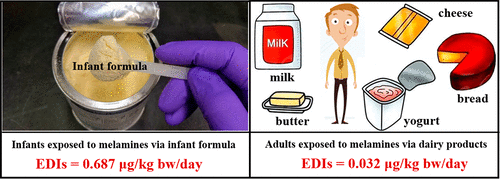当前位置:
X-MOL 学术
›
Environ. Sci. Technol. Lett.
›
论文详情
Our official English website, www.x-mol.net, welcomes your feedback! (Note: you will need to create a separate account there.)
Continuing Occurrence of Melamine and Its Derivatives in Infant Formula and Dairy Products from the United States: Implications for Environmental Sources
Environmental Science & Technology Letters ( IF 10.9 ) Pub Date : 2018-10-05 , DOI: 10.1021/acs.estlett.8b00515 Hongkai Zhu 1, 2 , Kurunthachalam Kannan 1, 2
Environmental Science & Technology Letters ( IF 10.9 ) Pub Date : 2018-10-05 , DOI: 10.1021/acs.estlett.8b00515 Hongkai Zhu 1, 2 , Kurunthachalam Kannan 1, 2
Affiliation

|
A total of 52 infant formulas and 42 dairy products, including milk, yogurt, cheese, and butter, as well as bread purchased from Albany, New York, were analyzed for melamine and its derivatives (cyanuric acid, ammeline, and ammelide). ∑Melamine (sum of melamine and its three derivatives) was found in infant formula, milk, yogurt, cheese, butter, and bread at median concentrations of 4.8, 7.9, 5.1, 17, 4.2, and 7.5 ng/g, respectively. Median ∑Melamine concentrations in infant formula collected in 2008 (9.4 ng/g) were significantly higher than those collected in 2018 (2.7 ng/g). Similarly, there were significant differences in ∑Melamine concentrations between powdered (median of 2.3 ng/g) and liquid forms (9.0 ng/g) of infant formula. However, no significant differences in ∑Melamine concentrations were found between milk-based (5.0 ng/g) and soy-based (2.3 ng/g) or between organic (4.4 ng/g) and nonorganic (4.8 ng/g) forms of infant formula. Cyanuric acid was the major derivative found in all products analyzed (68–83%), followed by melamine (7.0–21%), ammelide (2.5–10%), and ammeline (0–6.0%). The average daily intakes of ∑Melamine by U.S. infants via formula and adults via dairy products were 0.687 and 0.032 μg (kg of body weight)−1 day–1, respectively. Our study suggests ongoing but low-level contamination of food products marketed in the United States with melamine and its derivatives.
中文翻译:

美国婴儿配方奶和乳制品中三聚氰胺及其衍生物的持续存在:对环境来源的影响
分析了总共52种婴儿配方奶粉和42种乳制品,包括牛奶,酸奶,奶酪和黄油,以及从纽约奥尔巴尼(Albany)购买的面包,分析了三聚氰胺及其衍生物(氰尿酸,氨水和酰胺)。在婴儿配方奶粉,牛奶,酸奶,奶酪,黄油和面包中发现的三聚氰胺(三聚氰胺及其三种衍生物的总和)的中位数浓度分别为4.8、7.9、5.1、17、4.2和7.5 ng / g。2008年收集的婴儿配方奶粉中的三聚氰胺中位数浓度(9.4 ng / g)显着高于2018年收集的Σ三聚氰胺浓度(2.7 ng / g)。同样,婴儿配方奶粉的粉状(中位数为2.3 ng / g)和液体形式(9.0 ng / g)之间的三聚氰胺浓度也存在显着差异。但是,牛奶基牛奶中的Σ-三聚氰胺浓度没有显着差异(5。0 ng / g)和大豆基(2.3 ng / g)或有机(4.4 ng / g)和非有机(4.8 ng / g)婴儿配方奶粉之间。在所有分析的产品中,氰尿酸是主要衍生物(68–83%),其次是三聚氰胺(7.0–21%),乙酰胺(2.5–10%)和氨苯胺(0–6.0%)。美国婴儿通过配方奶粉和成年人通过乳制品摄入的三聚氰胺的平均每日摄入量分别为0.687和0.032μg(千克体重)-1天–1分别。我们的研究表明,在美国销售的食品中,三聚氰胺及其衍生物正在受到持续但低水平的污染。
更新日期:2018-10-06
中文翻译:

美国婴儿配方奶和乳制品中三聚氰胺及其衍生物的持续存在:对环境来源的影响
分析了总共52种婴儿配方奶粉和42种乳制品,包括牛奶,酸奶,奶酪和黄油,以及从纽约奥尔巴尼(Albany)购买的面包,分析了三聚氰胺及其衍生物(氰尿酸,氨水和酰胺)。在婴儿配方奶粉,牛奶,酸奶,奶酪,黄油和面包中发现的三聚氰胺(三聚氰胺及其三种衍生物的总和)的中位数浓度分别为4.8、7.9、5.1、17、4.2和7.5 ng / g。2008年收集的婴儿配方奶粉中的三聚氰胺中位数浓度(9.4 ng / g)显着高于2018年收集的Σ三聚氰胺浓度(2.7 ng / g)。同样,婴儿配方奶粉的粉状(中位数为2.3 ng / g)和液体形式(9.0 ng / g)之间的三聚氰胺浓度也存在显着差异。但是,牛奶基牛奶中的Σ-三聚氰胺浓度没有显着差异(5。0 ng / g)和大豆基(2.3 ng / g)或有机(4.4 ng / g)和非有机(4.8 ng / g)婴儿配方奶粉之间。在所有分析的产品中,氰尿酸是主要衍生物(68–83%),其次是三聚氰胺(7.0–21%),乙酰胺(2.5–10%)和氨苯胺(0–6.0%)。美国婴儿通过配方奶粉和成年人通过乳制品摄入的三聚氰胺的平均每日摄入量分别为0.687和0.032μg(千克体重)-1天–1分别。我们的研究表明,在美国销售的食品中,三聚氰胺及其衍生物正在受到持续但低水平的污染。



























 京公网安备 11010802027423号
京公网安备 11010802027423号